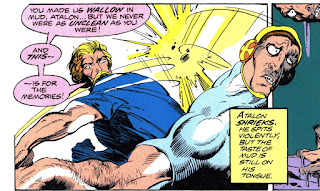Book Review: 'Last Rites' by Jorge Saralegui
'Last Rites' (279 pp.) was published by Charter / Berkley Books in November, 1985. The cover artist is uncredited.
The prologue of 'Rites' depicts, in a splatter-punkish way, a satanic ceremony, held in a San Francisco church in 1882 and overseen by an alluring woman named Lourdes.
The narrative then moves to San Francisco of the mid-1980s. Lead character Nick Van Lo, who has been booted out of a faculty position at an esteemed Bay-area university for sleeping with his female students, has moved to the Tenderloin district. Low on money, and steeped in no small amount of self-pity, Nick takes a room at an old hotel, called the La Casa de Dolores, now converted to a flophouse. Nick hopes to restore his reputation and his self-respect by teaching tenth-graders at the estimable John Swett School.
One of Van Lo's students is the angelic Amanda Westerhays, who, along with her affluent affluent parents Jessica and Tod, enjoys a comfortable lifestyle at their home in a suburb outside the city. Amanda thinks very highly of her new teacher, and Nick reciprocates the sentiment. So when Amanda begins to display aggressive behavior, it raises concerns with Nick.
Nick also can't help noticing that there is something disturbing going on at La Casa de Dolores. The mortality rate for its population of transients, alcoholics, and derelicts rapidly is rising. 'The Doctor', an amiable transient who mans the front desk, is drinking more heavily than usual. The carcasses of dead rats, drained of blood, are scattered around the premises. The eccentric Father Angustia, an 'urban missionary' who ministers to the tenants, hints that there are dark and dangerous forces at work in the building. And Dolores, the decrepit elderly woman who owns the hotel, declares that she knows a great deal about these disturbances........and the malevolent acts that sullied the city in 1882.
Even as Nick struggles to understand the strange things going on at the hotel, he meets a striking young woman named Judith Harper. Judith, with her long dark hair, white teeth, and fabulous figure, is like Vampirella come to life. And she only visits him at night................
'Last Rites' has an interesting premise: vampires on the loose in modern-day San Francisco, preying on the vagrants and the demimonde of the Tenderloin District, delivering erotic thrills in exchange for sucking the blood of their one-night stands.
Unfortunately, after the first 50 pages the narrative starts to lose cohesion, taking on the form of a series of vignettes that are tossed at the reader in a haphazard manner. The author adopts a prose approach common to many Paperbacks from Hell, introducing spooky incidents that may, or may not, be hallucinations and nightmares. These incidents tend to give the plot a nebulous quality, as the reader labors to elucidate if the evil is 'real', or merely a phantasm.
It doesn't help matters that the author's prose is stilted, and overly reliant on melodramatic passages that contravene the 'show, don't tell' mantra of fiction writing. Such passages are particularly pronounced in the novel's final fifty pages, which suffer from considerable padding en route to detailing the final confrontation between the vampires and the heroes.
The verdict ? 'Last Rites' is one of the more underwhelming Paperbacks from Hell. You're better off going with some of the other vampire novels that are plentiful in that category.


























































.jpg)




















